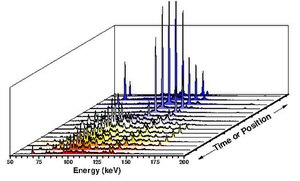Physics:Energy-dispersive X-ray diffraction
Energy-dispersive X-ray diffraction (EDXRD) is an analytical technique for characterizing materials. It differs from conventional X-ray diffraction by using polychromatic photons as the source and is usually operated at a fixed angle.[1] With no need for a goniometer, EDXRD is able to collect full diffraction patterns very quickly. EDXRD is almost exclusively used with synchrotron radiation which allows for measurement within real engineering materials.[2]
History
EDXRD was originally proposed independently by Buras et al. and Giessen and Gordon in 1968.[3]
Advantages
The advantages of EDXRD are (1) it uses a fixed scattering angle, (2) it works directly in reciprocal space, (3) fast collection time, and (4) parallel data collection. The fixed scattering angle geometry makes EDXRD especially suitable for in situ studies in special environments (e.g. under very low or high temperatures and pressures). When the EDXRD method is used, only one entrance and one exit window are needed. The fixed scattering angle also allows for measurement of the diffraction vector directly. This allows for high-accuracy measurement of lattice parameters. It allows for rapid structure analysis and the ability to study materials that are unstable and only exist for short periods of time. Because the whole spectrum of diffracted radiation is obtained simultaneously, it enables parallel data collection studies where structural changes can be determined over time.
Facilities
| Facility | Location | Beamline | Energy range (keV) |
|---|---|---|---|
| National Synchrotron Light Source | Upton, NY | X17B1[4] | 50–200 |
| Advanced Photon Source | Argonne, IL | 16-BM-B[5] | 10–120 |
| German Electron Synchrotron | Hamburg, DE | P61B[6] | 50–150 |
| Cornell High Energy Synchrotron Source | Ithaca, NY | B1[7] | unknown |
| Diamond Light Source | Oxfordshire, UK | I12[8] | 50–150 |
| SOLEIL | Paris, France | I03c[9] | 15–100 |
| Indus 2 | India | BL-11[10] | unknown |
References
- ↑ Kämpfe, B.; Luczak, F.; Michel, B. (2005). "Energy Dispersive X-Ray Diffraction". Part. Part. Syst. Charact. 22 (6): 391–396. doi:10.1002/ppsc.200501007. https://link.springer.com/article/10.1007/BF02396775. Retrieved March 16, 2014.
- ↑ "Energy Dispersive Diffraction". Diamond Light Source. http://www.diamond.ac.uk/Beamlines/Engineering-and-Environment/Techniques/EDD.html.
- ↑ Laine, E.; Lähteenmäki, I. (February 1980). "The energy dispersive X-ray diffraction method: annotated bibliography 1968–78". Journal of Materials Science 15 (2): 269–277. doi:10.1007/BF02396775. Bibcode: 1980JMatS..15..269L.
- ↑ "Beamline X17B1". Brookhaven National Laboratory. http://beamlines.ps.bnl.gov/beamline.aspx?blid=X17B1.
- ↑ "Beamline 16-BM-B: Sector 16 – Bending Magnet Beamline". Argonne National Laboratory. http://www.aps.anl.gov/Beamlines/Directory/beamline.php?beamline_id=87.
- ↑ "P61B Large Volume Press (DESY)". Helmholtz Association. https://photon-science.desy.de/facilities/petra_iii/beamlines/p61_high_energy_wiggler_beamline_lvp/p61b_large_volume_press_desy/index_eng.html.
- ↑ "CHESS West – B1". Cornell University. http://www.chess.cornell.edu/chess/west/B1.htm.
- ↑ "I12: Joint Engineering, Environmental, and Processing (JEEP)". Diamond Light Source. http://www.diamond.ac.uk/Home/Beamlines/I12.html.
- ↑ "PSICHÉ beamline". Synchrotron SOLEIL – L'Orme des Merisiers Saint-Aubin. http://www.synchrotron-soleil.fr/Recherche/LignesLumiere/PSICHE.
- ↑ Pandey, K. K. (April 2013). "Energy-dispersive X-ray diffraction beamline at Indus-2 synchrotron source". Pramana 80 (4): 607–619. doi:10.1007/s12043-012-0493-0. Bibcode: 2013Prama..80..607P.
 |



